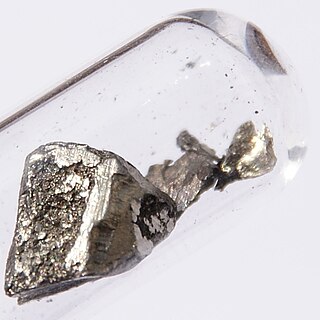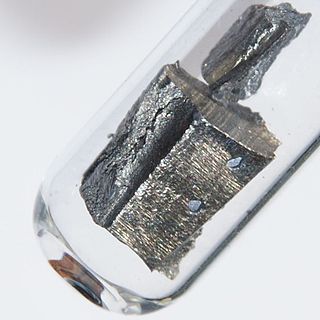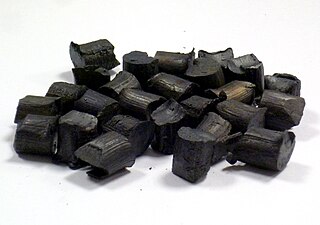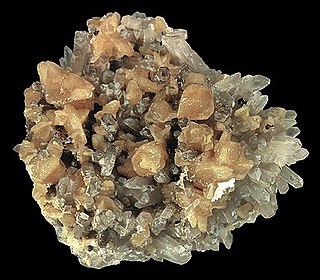
Lanthanum is a chemical element; it has symbol La and atomic number 57. It is a soft, ductile, silvery-white metal that tarnishes slowly when exposed to air. It is the eponym of the lanthanide series, a group of 15 similar elements between lanthanum and lutetium in the periodic table, of which lanthanum is the first and the prototype. Lanthanum is traditionally counted among the rare earth elements. Like most other rare earth elements, the usual oxidation state is +3, although some compounds are known with oxidation state +2. Lanthanum has no biological role in humans but is essential to some bacteria. It is not particularly toxic to humans but does show some antimicrobial activity.

Neodymium is a chemical element; it has symbol Nd and atomic number 60. It is the fourth member of the lanthanide series and is considered to be one of the rare-earth metals. It is a hard, slightly malleable, silvery metal that quickly tarnishes in air and moisture. When oxidized, neodymium reacts quickly producing pink, purple/blue and yellow compounds in the +2, +3 and +4 oxidation states. It is generally regarded as having one of the most complex spectra of the elements. Neodymium was discovered in 1885 by the Austrian chemist Carl Auer von Welsbach, who also discovered praseodymium. It is present in significant quantities in the minerals monazite and bastnäsite. Neodymium is not found naturally in metallic form or unmixed with other lanthanides, and it is usually refined for general use. Neodymium is fairly common—about as common as cobalt, nickel, or copper and is widely distributed in the Earth's crust. Most of the world's commercial neodymium is mined in China, as is the case with many other rare-earth metals.

The rare-earth elements (REE), also called the rare-earth metals or rare earths or, in context, rare-earth oxides, and sometimes the lanthanides, are a set of 17 nearly indistinguishable lustrous silvery-white soft heavy metals. Compounds containing rare earths have diverse applications in electrical and electronic components, lasers, glass, magnetic materials, and industrial processes.

Mischmetal (from German: Mischmetall – "mixed metal") is an alloy of rare-earth elements. It is also called cerium mischmetal, or rare-earth mischmetal. A typical composition includes approximately 55% cerium, 25% lanthanum, and 15~18% neodymium, with traces of other rare earth metals; it contains 95% lanthanides and 5% iron. Its most common use is in the pyrophoric ferrocerium "flint" ignition device of many lighters and torches, although an alloy of only rare-earth elements would be too soft to give good sparks. For this purpose, it is blended with iron oxide and magnesium oxide to form a harder material known as ferrocerium. In chemical formulae it is commonly abbreviated as Mm, e.g. MmNi5.

Monazite is a primarily reddish-brown phosphate mineral that contains rare-earth elements. Due to variability in composition, monazite is considered a group of minerals. The most common species of the group is monazite-(Ce), that is, the cerium-dominant member of the group. It occurs usually in small isolated crystals. It has a hardness of 5.0 to 5.5 on the Mohs scale of mineral hardness and is relatively dense, about 4.6 to 5.7 g/cm3. There are five different most common species of monazite, depending on the relative amounts of the rare earth elements in the mineral:

The mineral bastnäsite (or bastnaesite) is one of a family of three carbonate-fluoride minerals, which includes bastnäsite-(Ce) with a formula of (Ce, La)CO3F, bastnäsite-(La) with a formula of (La, Ce)CO3F, and bastnäsite-(Y) with a formula of (Y, Ce)CO3F. Some of the bastnäsites contain OH− instead of F− and receive the name of hydroxylbastnasite. Most bastnäsite is bastnäsite-(Ce), and cerium is by far the most common of the rare earths in this class of minerals. Bastnäsite and the phosphate mineral monazite are the two largest sources of cerium and other rare-earth elements.

Praseodymium is a chemical element; it has symbol Pr and the atomic number 59. It is the third member of the lanthanide series and is considered one of the rare-earth metals. It is a soft, silvery, malleable and ductile metal, valued for its magnetic, electrical, chemical, and optical properties. It is too reactive to be found in native form, and pure praseodymium metal slowly develops a green oxide coating when exposed to air.

Didymium is a mixture of the elements praseodymium and neodymium. It is used in safety glasses for glassblowing and blacksmithing, especially with a gas (propane)-powered forge, where it provides a filter that selectively blocks the yellowish light at 589 nm emitted by the hot sodium in the glass without having a detrimental effect on general vision, unlike dark welder's glasses. The usefulness of didymium glass for eye protection of this sort was discovered by Sir William Crookes.

Carl Gustaf Mosander was a Swedish chemist. He discovered the rare earth elements lanthanum, erbium and terbium.

Allanite (also called orthite) is a sorosilicate group of minerals within the broader epidote group that contain a significant amount of rare-earth elements. The mineral occurs mainly in metamorphosed clay-rich sediments and felsic igneous rocks. It has the general formula A2M3Si3O12[OH], where the A sites can contain large cations such as Ca2+, Sr2+, and rare-earth elements, and the M sites admit Al3+, Fe3+, Mn3+, Fe2+, or Mg2+ among others. However, a large amount of additional elements, including Th, U, Be, Zr, P, Ba, Cr and others may be present in the mineral. The International Mineralogical Association lists four minerals in the allanite group, each recognized as a unique mineral: allanite-(Ce), allanite-(La), allanite-(Nd), and allanite-(Y), depending on the dominant rare earth present: cerium, lanthanum, neodymium or yttrium.

Abenakiite-(Ce) is a mineral of sodium, cerium, neodymium, lanthanum, praseodymium, thorium, samarium, oxygen, sulfur, carbon, phosphorus, and silicon with a chemical formula Na26Ce6(SiO3)6(PO4)6(CO3)6(S4+O2)O. The silicate groups may be given as the cyclic Si6O18 grouping. The mineral is named after the Abenaki, an Algonquian Indian tribe of New England. Its Mohs scale rating is 4 to 5.

Carl Axel Arrhenius was a Swedish military officer, amateur geologist, and chemist. He is best known for his discovery of the mineral ytterbite in 1787.

Yttrium is a chemical element; it has symbol Y and atomic number 39. It is a silvery-metallic transition metal chemically similar to the lanthanides and has often been classified as a "rare-earth element". Yttrium is almost always found in combination with lanthanide elements in rare-earth minerals and is never found in nature as a free element. 89Y is the only stable isotope and the only isotope found in the Earth's crust.

Cerium is a chemical element; it has symbol Ce and atomic number 58. Cerium is a soft, ductile, and silvery-white metal that tarnishes when exposed to air. Cerium is the second element in the lanthanide series, and while it often shows the oxidation state of +3 characteristic of the series, it also has a stable +4 state that does not oxidize water. It is also considered one of the rare-earth elements. Cerium has no known biological role in humans but is not particularly toxic, except with intense or continued exposure.

Zirsilite-(Ce) is a very rare mineral of the eudialyte group, with formula (Na,□)12(Ce,Na)3Ca6Mn3Zr3NbSi(Si9O27)2(Si3O9)2O(OH)3(CO3)·H2O. The original formula was extended to show the presence of cyclic silicate groups and the presence of silicon at the M4 site, according to the nomenclature of the eudialyte group. Zirsilite-(Ce) differs from carbokentbrooksite in cerium-dominance over sodium only. Both minerals are intimately associated. The only other currently known representative of the eudialyte group having rare earth elements (in particular cerium, as suggested by the "-Ce)" Levinson suffix in the name) in dominance is johnsenite-(Ce).

Ferrokentbrooksite is a moderately rare mineral of the eudialyte group, with formula Na15Ca6(Fe,Mn)3Zr3NbSi25O73(O,OH,H2O)3(Cl,F,OH)2. The original formula was extended form to show the presence of cyclic silicate groups and presence of silicon at the M4 site, according to the nomenclature of eudialyte group. As suggested by its name, it is the (ferrous) iron analogue of kentbrooksite. When compared to the latter, it is also chlorine-dominant instead of being fluorine-dominant. The original (holotype) material is also relatively enriched in rare earth elements, including cerium and yttrium.
Oneillite is a rare mineral of the eudialyte group with the chemical formula Na15Ca3Mn3Fe2+3Zr3NbSiO(Si3O9)2(Si9O27)2(O,OH,H2O)3(OH,Cl)2. The formula is based on the original one but extended to show the presence of cyclic silicate groups and domination of Si at the M4 site. The mineral has lowered symmetry (space group R3, instead of more specific for the group R3m one) due to Ca-Mn ordering. Similar feature is displayed by some other eudialyte-group members: aqualite, labyrinthite, raslakite, and voronkovite. Oneillite is strongly enriched in rare earth elements (REE, mainly cerium), but REE do not dominate any of its sites.
Florencite-(Sm) is a very rare mineral of the plumbogummite group (alunite supergroup) with simplified formula SmAl3(PO4)2(OH)6. Samarium in florencite-(Sm) is substituted by other rare earth elements, mostly neodymium. It does not form separate crystals, but is found as zones in florencite-(Ce), which is cerium-dominant member of the plumbogummite group. Florencite-(Sm) is also a samarium-analogue of florencite-(La) (lanthanum-dominant) and waylandite (bismuth-dominant), both being aluminium-rich minerals.
Anzaite-(Ce) is a rare-earth element (REE) oxide mineral with the formula Ce4Fe2+Ti6O18(OH)2. An example of chemically related mineral is lucasite-(Ce), although it contains no iron. Cerium in anzaite-(Ce) is mainly substituted by neodymium, lanthanum, calcium and praseodymium. Titanium is substituted by niobium. Trace elements include thorium. The mineral is monoclinic, space group C2/m. Anzaite-(Ce) is hydrothermal mineral found in a carbonatite from the mineralogically prolific Kola Peninsula. The mineral name honors Anatoly N. Zaitsev, who is known for studies of carbonatites and REE.

Cerianite-(Ce) is a relatively rare oxide mineral, belonging to uraninite group with the formula (Ce,Th)O
2. It is one of a few currently known minerals containing essential tetravalent cerium, the other examples being stetindite and dyrnaesite-(La).

















